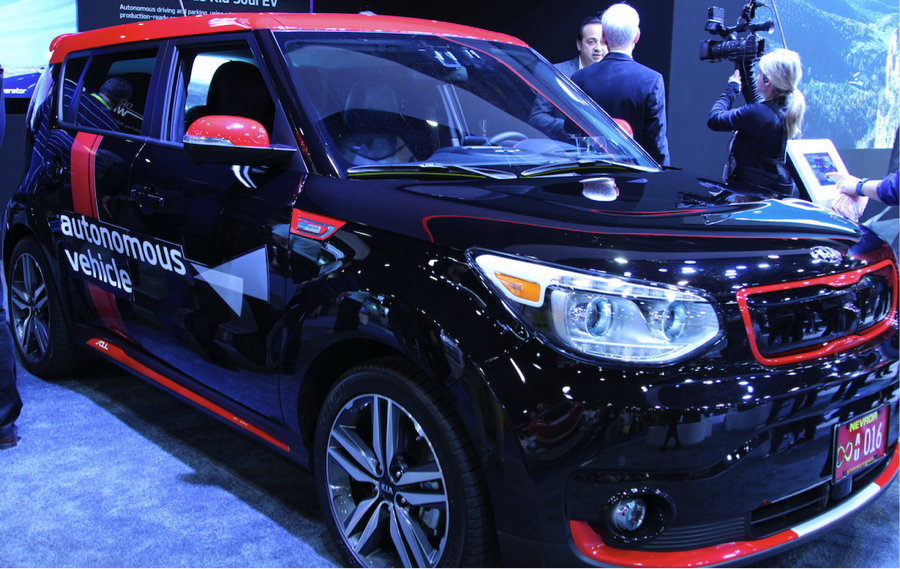
Kia will develop intelligent vehicles that feature a range of Advanced Drive Assistance Systems (ADAS) to control them and keep them safe on public roads. It will begin manufacturing partially autonomous cars by 2020 and aims to bring the first fully autonomous vehicle to market by 2030.
While truly autonomous vehicles are still some time away for everyday use, Kia gave visitors at the 2016 Consumer Electronics Show (CES) show a chance to experience a host of next generation technologies and concepts with interactive displays.
The technologies included:
Highway Autonomous Driving (HAD) employs a combination of radar and camera detection systems to interpret lane markings, allowing the car to stay in its lane, switch lanes to overtake vehicles or follow a different road; all without driver input.
Urban Autonomous Driving (UAD) applies GPS and sensors to identify the car’s position on the road, allowing it to safely navigate through densely congested city environments while responding to live traffic updates.

Preceding Vehicle Following (PVF) is an enhanced lane-keeping system, which monitors the vehicle in front and allows the car to calculate its own path relative to it, following at a safe distance if road markings are indecipherable due to poor conditions or road layout.
Emergency Stop System (ESS), which operates in correlation with Kia’s Driver Status Monitoring (DSM) system, analyses the driver’s face, ensuring their attention does not stray from the road for too long. If it detects the driver’s eyes have been off the road for too long, ESS can automatically direct the car into an appropriate side lane and come to a halt.
Traffic Jam Assist (TJA) monitors the vehicle in front during congested traffic conditions, maintaining a safe distance and moving into appropriate spaces to gain ground.
Autonomous Valet Parking allows drivers to exit the car and let the vehicle park itself remotely, activated using the smart key or smartwatch.
As well as controlling the car in outside environments, autonomous technologies are also being developed to improve interaction between the driver and vehicle itself.
A special I-Cockpit display at the CES show featured Kia’s innovative new Human Machine Interface (HMI) functions, where a fingerprint touchpad and gesture recognition are used to operate the car’s controls. Automatically recognizing individual drivers’ preferences on start-up, based on their fingerprint or smartwatch, the car dials up the driver’s favourite music, preferred climate control settings and the type of information displayed by the instrument panel.
The driver’s gestures are recognized by the I-Cockpit if they want to change any settings in the cabin, without taking their eyes off the road ahead.
The autonomous technologies will be tested on public roads in the US soon following approval by the state of Nevada to license Kia to utilize autonomous driving technologies on a specifically modified Soul EV. The all-electric Soul EV - Kia’s first globally sold electric car - is being used as the brand’s testbed for the development of next generation autonomous technologies on roads around Death Valley.
While some of those technologies will be introduced to Kia partially autonomous vehicles by 2020, it will take another 15 years for the next step of fully autonomous driving to be achieved, as it will require the development of a vehicle-to-everything (V2X) communications system.
To bring the true ‘self-driving car’ to market by 2030, Kia says V2X must be fully integrated into real-life driving environments and be able to react as a human driver can.
V2X applies a series of sensors, radar, LiDAR (Light Detection And Ranging radar) and external cameras to perceive the surrounding environment and all relevant obstacles, as a human driver does. The system also incorporates vehicle-to-vehicle (V2V) and vehicle-to-infrastructure (V2I) technologies allowing the car to recognize, judge and control every driving scenario, obstacle or potential threat.
Kia has committed to a preliminary investment of US$2 billion by 2018 in order to fast track development its new autonomous technologies.
Source

No comments:
Post a Comment